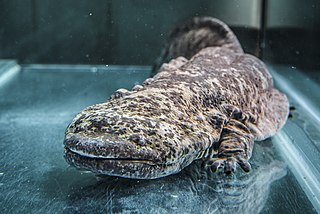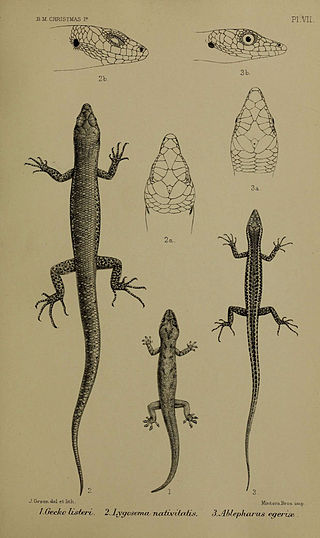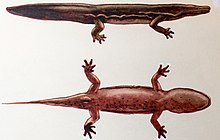
The hellbender, also known as the hellbender salamander, is a species of aquatic giant salamander endemic to the eastern and central United States. It is the largest salamander in North America. A member of the family Cryptobranchidae, the hellbender is the only extant member of the genus Cryptobranchus. Other closely related salamanders in the same family are in the genus Andrias, which contains the Japanese and Chinese giant salamanders. The hellbender, which is much larger than all other salamanders in its geographic range, employs an unusual means of respiration, and fills a particular niche—both as a predator and prey—in its ecosystem, which either it or its ancestors have occupied for around 65 million years. The species is listed as Vulnerable on the IUCN Red List of Threatened Species due to the impacts of disease and widespread habitat loss and degradation throughout much of its range.

The Cryptobranchidae are a family of fully aquatic salamanders commonly known as the giant salamanders. They include some of the largest living amphibians. The family is native to China, Japan, and the eastern United States. They constitute one of two living families—the other being the Asiatic salamanders belonging to the family Hynobiidae—within the Cryptobranchoidea, one of two main divisions of living salamanders.

Armand David, CM was a Lazarist missionary Catholic priest as well as a zoologist and a botanist.

The Qinling or Qin Mountains, formerly known as the Nanshan, are a major east–west mountain range in southern Shaanxi Province, China. The mountains mark the divide between the drainage basins of the Yangtze and Yellow River systems, providing a natural boundary between North and South China and support a huge variety of plant and wildlife, some of which is found nowhere else on earth.

Taylor's salamander is a species of salamander found only in Laguna Alchichica, a high-altitude crater lake to the southwest of Perote, Mexico. It was first described in 1982 but had been known to science prior to that. It is a neotenic salamander, breeding while still in the larval state and not undergoing metamorphosis. The lake in which it lives is becoming increasingly saline and less suitable for the salamander, which is declining in numbers. The International Union for Conservation of Nature (IUCN) has rated it as being "critically endangered".

The radiated tortoise is a tortoise species in the family Testudinidae. Although this species is native to and most abundant in southern Madagascar, it can also be found in the rest of this island, and has been introduced to the islands of Réunion and Mauritius. It is a very long-lived species, with recorded lifespans of up to 188 years. These tortoises are classified as critically endangered by the IUCN, mainly because of the destruction of their habitat and because of poaching.

The Japanese giant salamander is a species of fully aquatic giant salamander endemic to Japan, occurring across the western portion of the main island of Honshu, with smaller populations present on Shikoku and in northern Kyushu. With a length of up to 5 feet (1.5 m), it is the third-largest salamander in the world, only being surpassed by the very similar and closely related Chinese giant salamander and the South China giant salamander.

The Yangtze giant softshell turtle, also known commonly as the Red River giant softshell turtle, the Shanghai softshell turtle, the speckled softshell turtle, and Swinhoe's softshell turtle, is an extremely rare species of turtle in the family Trionychidae. It may be the largest living freshwater turtle in the world. The species is native to eastern and southern China and northern Vietnam. With a known population of only two or three individuals, and with the last known females dying out, this species is considered functionally extinct.

The Chinese giant salamander is one of the largest salamanders and one of the largest amphibians in the world. It is fully aquatic, and is endemic to rocky mountain streams and lakes in the Yangtze river basin of central China. It has also been introduced to Kyoto Prefecture in Japan, and possibly to Taiwan. It is considered critically endangered in the wild due to habitat loss, pollution, and overcollection, as it is considered a delicacy and used in traditional Chinese medicine. On farms in central China, it is extensively farmed and sometimes bred, although many of the salamanders on the farms are caught in the wild. It has been listed as one of the top-10 "focal species" in 2008 by the Evolutionarily Distinct and Globally Endangered project.
Pseudoeurycea nigromaculata, commonly known as the black-spotted salamander or black-spotted false brook salamander is a species of salamander in the family Plethodontidae. It is endemic to Veracruz, Mexico, and known from Cerro Chicahuaxtla ) in Cuatlalpan and from Volcán San Martín at elevations of 1,200–1,300 m (3,900–4,300 ft). These separate populations likely represent distinct species.

Evolutionarily Distinct and Globally Endangered (EDGE) species are animal species which have a high 'EDGE score', a metric combining endangered conservation status with the genetic distinctiveness of the particular taxon. Distinctive species have few closely related species, and EDGE species are often the only surviving member of their genus or even higher taxonomic rank. The extinction of such species would therefore represent a disproportionate loss of unique evolutionary history and biodiversity.

Andrias is a genus of giant salamanders. It includes the largest salamanders in the world, with A. japonicus reaching a length of 1.44 metres, and A. sligoi reaching 1.80 metres. While extant species are only known from East Asia, several extinct species in the genus are known from late Oligocene and Neogene aged fossils collected in Europe and North America, indicating that the genus formerly had a much wider range.
Bolitoglossa nussbaumi is a lungless salamander in the family Plethodontidae endemic to Guatemala.

The Christmas Island forest skink, also known as the Christmas Island whiptail skink, is a species of skink formerly endemic to Australia's Christmas Island. As of 2017, it is listed as extinct on the IUCN Red List. The last known forest skink, a captive individual named Gump, died on 31 May 2014.

George Ulick Browne, 6th Marquess of Sligo and 4th Earl of Clanricarde, styled Earl of Altamont until 1913, was an Irish peer.

The Jiangxi giant salamander is a species of very large salamander endemic to Jiangxi Province in China. It is the only Chinese Andrias species known to have a genetically pure wild population.

Andrias matthewi, or Matthew's giant salamander, is an extinct species of giant salamander from the Miocene of North America. It belongs to the genus Andrias, which contains the living Asian giant salamanders. It is the largest salamander to have ever existed, with a maximum estimated length of 2.3 m. Its fossils have been found in Nebraska, Colorado, and Saskatchewan.
The Qimen giant salamander is a species of giant salamander in the family Cryptobranchidae. It is endemic to Anhui Province, China, where it inhabits streams and caves in the Huangshan Mountains. The species name honors Pihui Chen, a herpetologist at Anhui Normal University. The common name references its type locality in Qimen County.

















